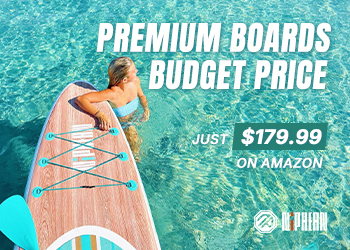Your paddle choice can have even more impact on the quality of your paddleboarding experience than your board choice. Supboardguide.com writer Bill Dawes takes you through the process of how to choose the right paddle for you.
Your paddleboarding experience essentially comes down to just two items – your board and your paddle. (Yes, you need your safety equipment as well, but that stuff is about ensuring you get home in one piece, it isn’t part of the actual physical experience). Arguably in fact, your paddle has even more impact on the quality of your paddleboarding experience than the board does, for two reasons.
Firstly, your paddle is what moves you through the water – the best analogy being that it is like the tyres on your bike. It takes the power that your body has created, and turns it into drive. Just as you need the right width and style of tires for the surface you’re riding on, so you need the right size and style of paddle for the paddleboarding you’re going to do. Having the right paddle really matters.
Even more importantly though, your paddle is your physical connection to the experience. Yes, we get sensory input from how the board tracks through the water and everything that’s going on around us, but in terms of actual hands-on connection to the activity we’re doing, it’s all right there in the paddle. The sensation, the feel, the connection, the load, the forces, it’s all coming from your paddle. Our relationship to our paddle pretty much IS the sum total of the paddleboarding experience, in physical terms.
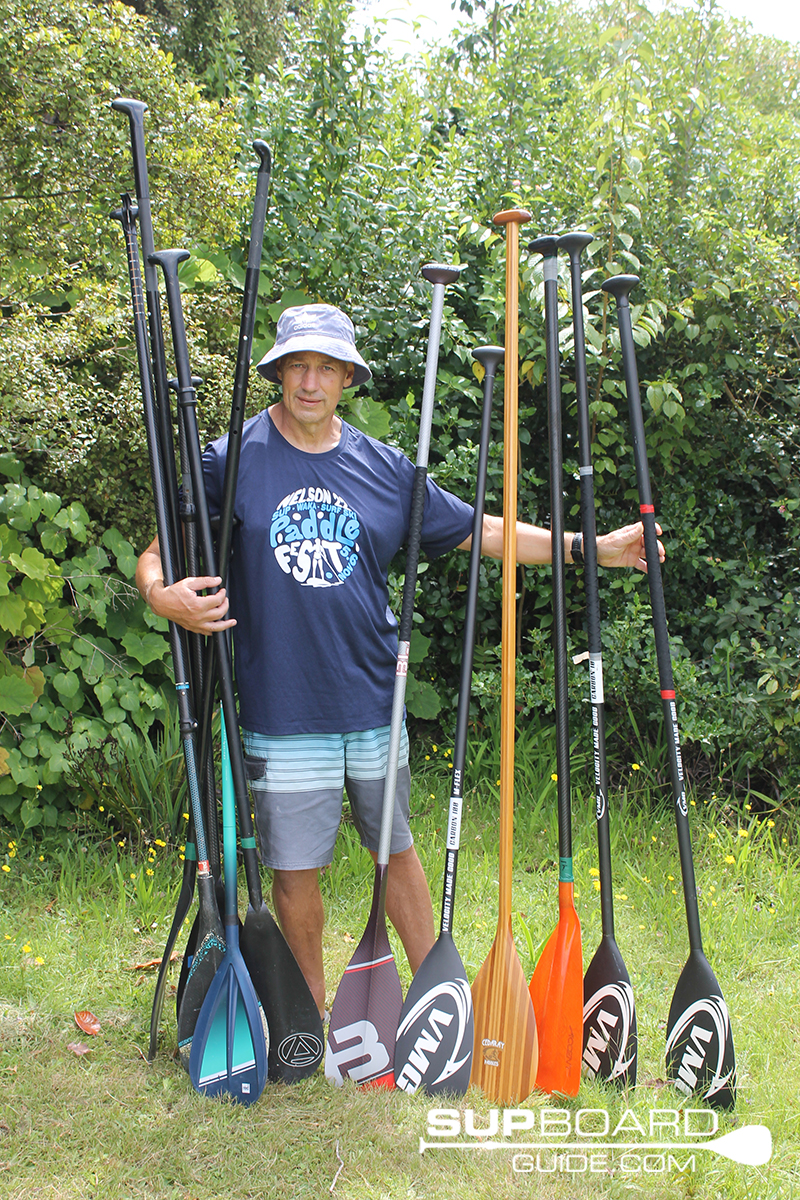
This is why having the right paddle is so important. With the right paddle, it actually doesn’t really matter what board you’re on, you’ll be feeling good. If it’s wrong – it won’t ever feel good. A paddle of the wrong length, with the wrong blade size, or – most commonly – one that just isn’t very good, is massively impacting on the quality of your paddleboarding experience. It’s like trying to play the piano when half the keys don’t work. Or play a round of golf with just a putter in your bag. If that’s all you’ve got, you’ll make it work, and you may well still have a good time. But then one day, someone will lend you a wedge to add to the putter in your golf bag, or you’ll get to play on a piano where all the keys do work, and you’ll suddenly realize what you’ve been missing.
Unfortunately, the vast majority of stand up paddleboarders haven’t yet realized what they’re missing, primarily due to the fact that most paddleboards (including a depressingly large number of quite high performance boards) are sold with very poor quality paddles to keep the overall package price low. So there are an awful lot of bad paddles out there. And then there are a whole lot of much better paddles, but of the wrong size, style or stiffness for the user, which are also greatly reducing the quality of their experience.
Don’t get me wrong – these paddles will still work. They just don’t work as well. A paddle that is the wrong size, style or stiffness for the user, or simply a poor quality paddle, is slower, heavier, more tiring and generally exerts a lot more strain on the body, potentially leading to injury.
And even if you do get a nice paddle of the right size, style and stiffness – it still needs to feel right. If the handle style or shaft section or diameter doesn’t suit your hands, it’s not going to work.
So the first really important takeaway from this article is that investing in the best and most comfortable paddle you can lay your hands on is a really really smart thing to do, and it will hugely improve your performance, your enjoyment, and reduce your risk of injury.
Indeed, the truth is that a good paddle used with a bad board is generally still a much better experience than a bad paddle used with a good board. If you are into (or getting into) paddleboarding because you want exercise, you want to paddle reasonable distances, you want to explore, go places, you want a serene and enjoyable experience on the water, you want to race or surf, or indeed you want to do pretty much anything above messing-around-at-the-lake-shore a couple of times a year, then the very best thing you can do to improve your paddling experience is upgrade your paddle. And that’s what this article is about – how to choose the right SUP paddle for you.
What are the Differences between SUP Paddles?
Before going any further, let’s look at the variables that actually make one paddle different from another. Firstly, of course, there is the visual appearance; the colour scheme and graphics. You have to like the look of your paddle! But this is cosmetic, and totally down to your individual taste, so we’ll leave that one to you. In terms of performance and function, we have 12 distinct parameters that define a paddle. Working from top to bottom, we have.
- Handle style
- Shaft construction (ie what the shaft is made of)
- Shaft section (round or oval)
- Shaft diameter
- Shaft stiffness
- Rake (angle between shaft and blade)
- Blade construction (ie what the blade is made of)
- Blade size
- Blade shape
- Paddle configuration (number of pieces, length adjustment system etc)
- Paddle weight
- Paddle length
Any and every one of these can make or break a paddle in terms of whether it’s the right one for you. Yet when you’re shopping for a paddle, you’ll struggle to find comparative information (or options) on more than a few of them. So, let’s work through the list and discuss each in more detail, before we look at how you choose the best paddle for your particular requirements.
Handle style
Paddle handles were originally just a simple crossbar, known (somewhat unimaginatively) as the tee piece. Now there are a range of ‘contoured’ styles available, ergonomically shaped so that they sit comfortably into the palm of your hand, with your fingers wrapped comfortably over the top. Contoured paddlers are generally rather nicer in feel and definitely more comfortable for longer distances. Some SUP surfers still prefer the simple T however, as it’s easier to twist and control the angle of the paddle; the contoured handle is a bit less precise in terms of orientation in the hands.
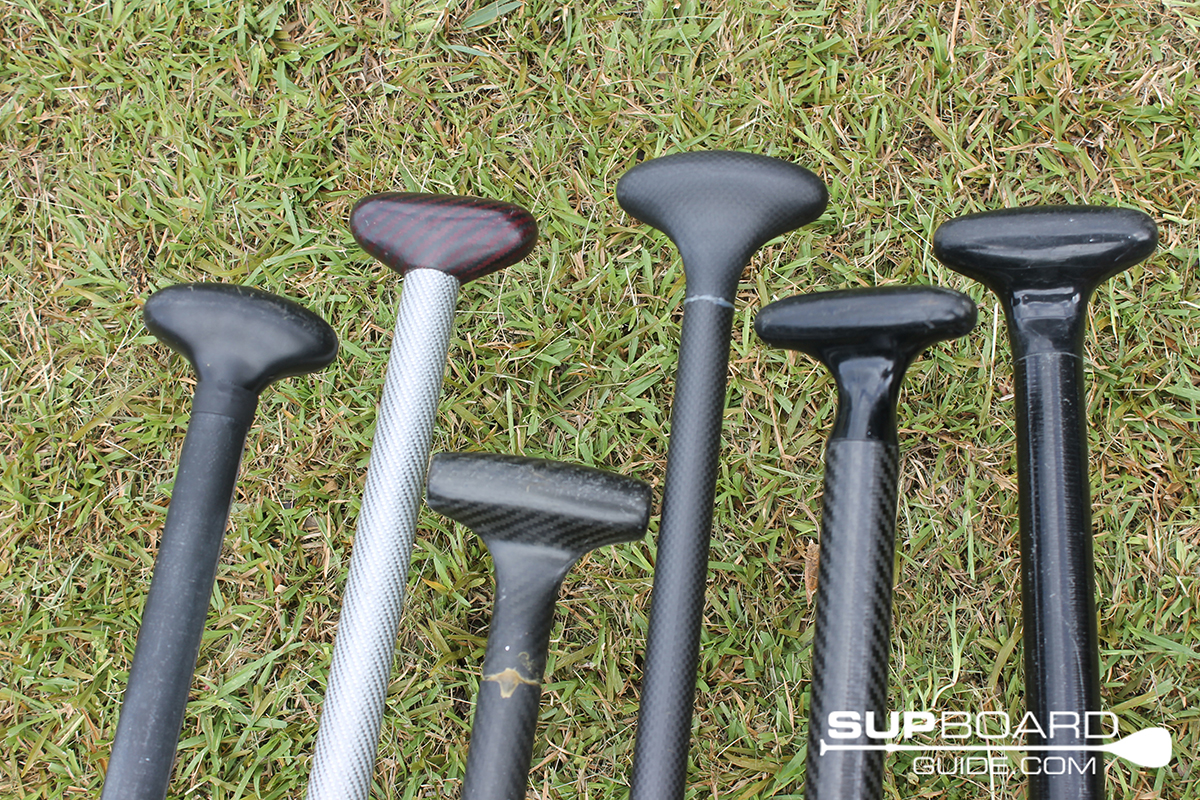
The quality and feel of the contoured handle often isn’t anything to do with the price point or the other paddle spec. I’ve come across fabulous handles on super cheap paddles, and handles that really felt weird to me on very expensive paddles. So this one is pretty much totally a matter of personal preference. But it’s important! So be sure to check out the feel of the handle when you’re choosing a paddle. Try a bunch of different handles to see what suits your hand and grip. In truth, because you should never be gripping tightly with your top hand anyway, you can usually adapt to pretty much any handle. Nevertheless, if you really don’t like the feel of a particular handle this could be a deal breaker, even if the rest of the paddle seems great. You can buy accessory handles so it may be possible to swap the handle, particularly if the shaft is round section (see below). But if the handle isn’t going to be easy to swap, and it just doesn’t feel good, then that isn’t the right paddle for you
Shaft construction
There are five types of shaft construction in use.
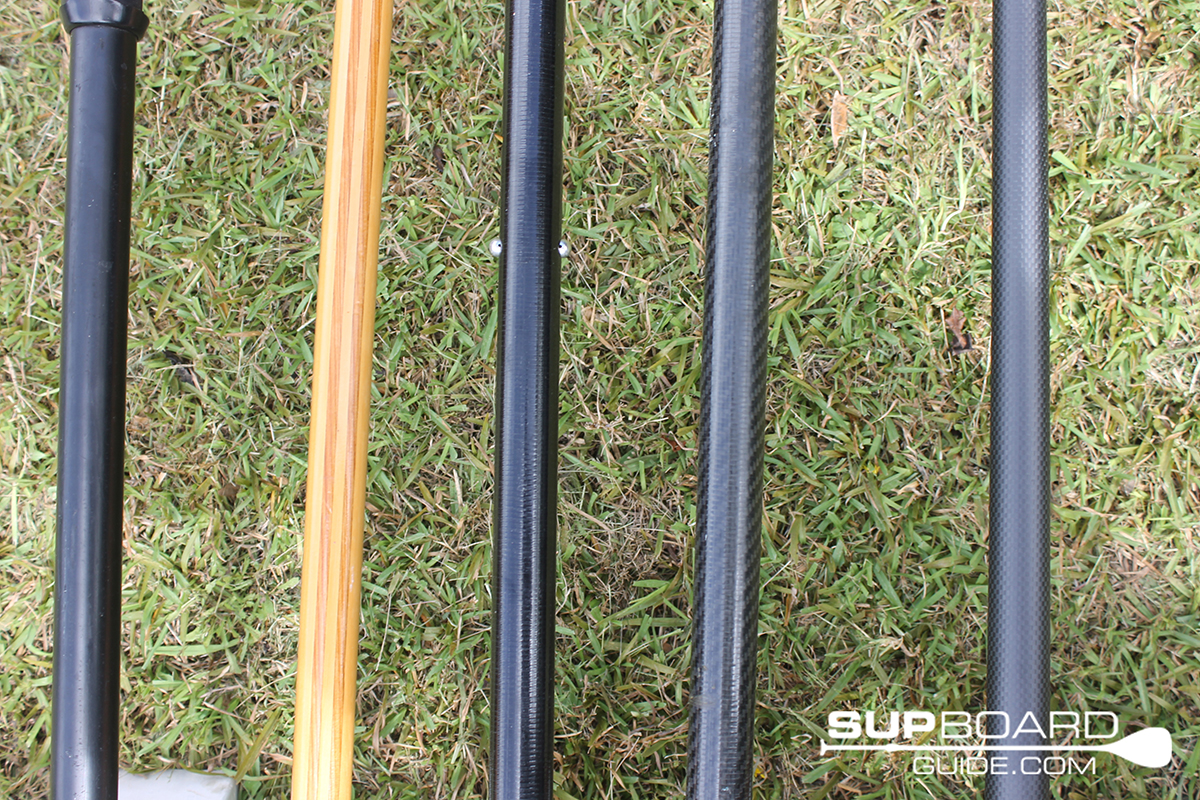
Aluminum is by far the cheapest, but is heavy, dead-feeling, cold to the touch, prone to sinking, and extremely prone to reacting with salt water to ensure that any adjustment or assembly mechanisms swiftly get jammed up unless the paddle is stripped apart and rinsed very regularly (like after each use) with fresh water. As you can probably tell, I’m not a fan of aluminum paddles! Yes, they’re cheap – but they’re also an extremely low quality paddleboarding experience.
Fiberglass is a little more expensive but makes for a vastly improved paddling experience. Fiberglass shafts are robust, have a nice flex, are lighter than aluminum and generally just nicer all round.
Composite shafts are made of a mix of fiberglass and carbon cloth. Increasing the carbon content makes the paddle lighter, stiffer and improves the response of the paddle, but it also increases the cost. Composite paddles can be anything from 5% carbon to 95% carbon. Higher carbon content usually indicates a higher-performance paddle.
Full carbon paddles are actually quite rare; the majority of paddles that claim to be carbon still include a percentage of fiberglass, simply because all-carbon paddles – while impressively light – are actually quite brittle and very intolerant of abuse. They’re also pretty pricey! If they’re not, then treat them with suspicion. There are different qualities of carbon, and different ways of using it. There are plenty of ‘full carbon’ paddles out there that just feel lifeless and awful. Generally, if it’s from a reputable brand it should be OK, but a good way to tell is simply the weight. A full carbon paddle should be pretty damn light; if it’s not, then it might be one to avoid.
Wood paddles are pretty rare now, as they tend to be just a bit heavier, and are also very time-intensive to build. A well-made wood paddle is a thing of beauty though, and just feels good in the hands. However, they’re best thought of as a specialist item for the committed enthusiast, rather than a mainstream paddle to be considered as an upgrade purchase.
Shaft section
Most paddle shafts are round, but some brands go for oval, because allegedly it’s stronger, has less lateral flex and some people find the oval section more pleasing under the hands. Some surfers really prefer the oval section as it gives you instant orientation on which way your blade is facing when you’re quickly changing sides, or after a wipeout when you need to get a few strokes in super quickly before the next wall of white water hits you. On the con side, there are less options for changing handles with oval-shaft paddles.
Shaft diameter
Round shafts can range from under 25mm to 30mm+, and the diameter makes a significant difference in feel. It’s particularly important if you have small hands, in which case a narrower diameter is a whole lot less fatiguing. It’s less important for bigger-handed people, but nevertheless, people often naturally favor a smaller diameter; it just feels nicer in the hand, with a better connection. Having said that, some brands go for a shaft that tapers significantly towards the handle, which isn’t to everyone’s liking. The moral of the story is: Wherever possible, if considering a paddle that is a different diameter to what you’re used to, it’s worth trying it first.
Shaft stiffness
A stiffer shaft is in principle more efficient as the paddle flexes less, thus transferring more of the power directly to the blade. Heavier and stronger folk should generally opt for a stiffer paddle, as they will naturally exert more force (and therefore bend) onto the shaft. However, a shaft too stiff for your paddling style and strength will be very tiring, and puts significantly more strain on your shoulders and arm joints. So you really don’t want too stiff a paddle. For lighter and/or less strong folk, it’s important to opt for a less stiff paddle. If in doubt, especially in your early stages of paddleboarding, you should err on the side of less stiff, as it’s just easier and more user friendly. Think of stiffness being akin to the shock absorbers on your car. For your family car it’s just nice to have a smooth ride; you’re not out there to win races. Whereas higher performance cars will have much stiffer suspension.
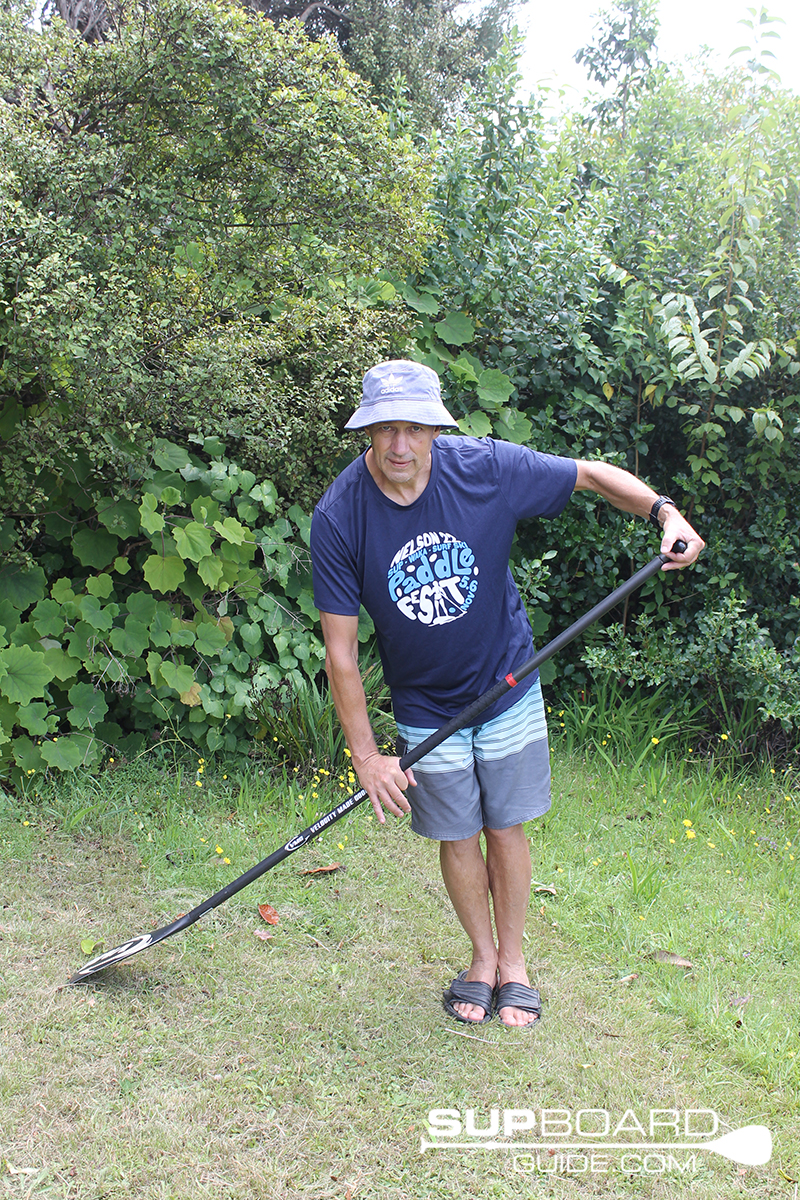
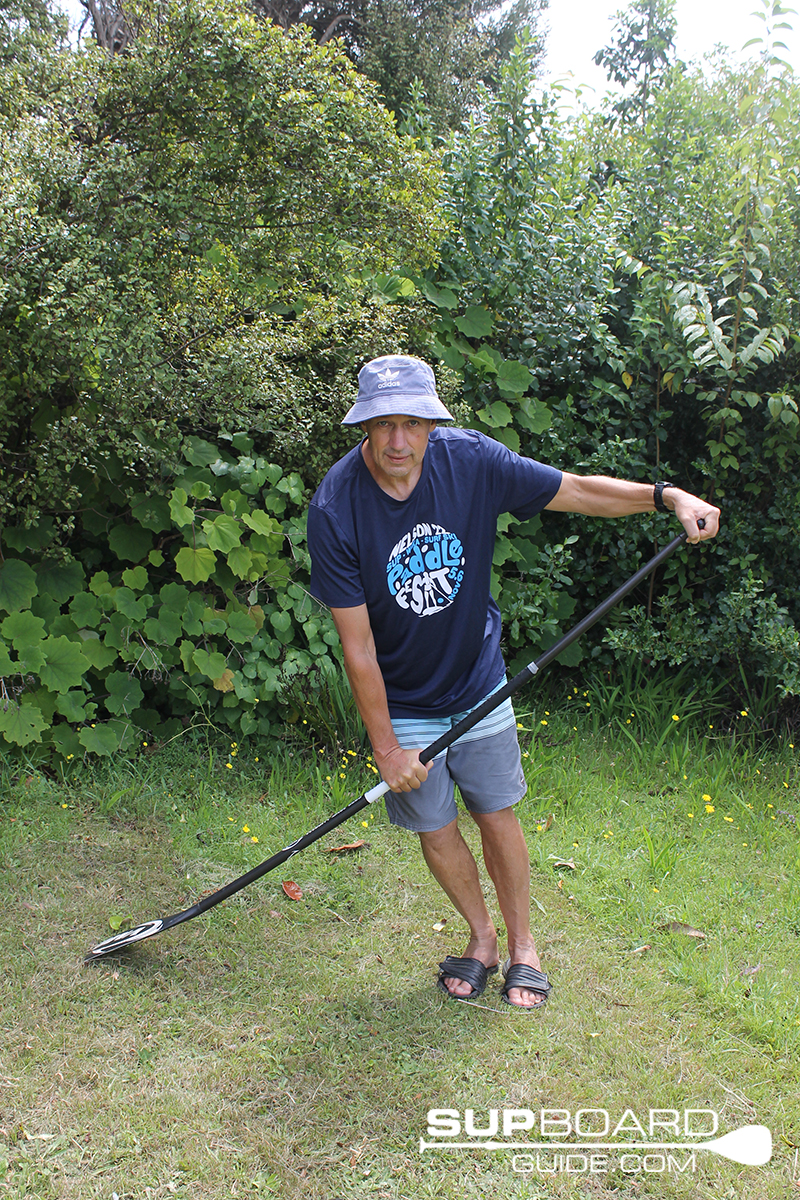
The paddle on the left has a very stiff shaft, and clearly deforms less under load than the medium-stiffness shaft on the right.
A softer shaft is also great for paddling longer distances as it’s less tiring. However, there is less acceleration with a softer paddle, which is why sprinters prefer stiffer shafts – as do many paddle surfers for that quick acceleration onto the wave. (Although probably an equal percentage of paddle surfers reckon that a softer shaft is much easier to feel the wave with and crank your board around on the face, so yet again, there’s an element of personal preference!).
Having said all that, it’s only when you get into the realms of composite paddles that stiffness actually even becomes a variable. Alu and fiberglass paddles come as they are, and there isn’t actually much variation within either group. Alu tends to be pretty stiff (indeed too stiff for smaller paddlers), while fiberglass is generally quite flexy (perhaps too flexy for heavier paddlers). Shaft stiffness in composite paddles is largely controlled by the carbon content, but also the way the paddle is built, so it’s not just about looking for the highest carbon percentage. Many brands offer the same set-up of handle and blade with a variety of different paddle shaft stiffness options. Unfortunately, despite a few brands attempting to introduce one, there is no standard measurement of paddle shaft stiffness yet (like the IMCS system that exists for windsurfing masts, for example), so there isn’t any way to compare the relative stiffnesses of different paddle brands. One brand’s “medium” may be stiffer than another brand’s “super stiff”. We just don’t know.
What happens to paddles when you cut them shorter?
If you buy a fixed length paddle of a particular stiffness, and cut it shorter, the result will be a (relatively) stiffer paddle. If you’re just cutting a few inches off it’ll not make a significant difference, but if you wanting a short, fairly flexy paddle for surfing, for example, in which case you’ll be cutting it down quite a bit, then go for a slightly softer shaft than you were originally planning on.
Understanding ‘Response’
A quick side-note here; you’ll often hear ‘response’ talked about in relation to paddles. Essentially what this is referring to is how quickly and smoothly the paddle recovers from being put under load. In crudest terms, how ‘boingy’ the paddle is. Every paddle will bend if you put enough load on it, but how quickly it regains shape has a major influence on how much power is transmitted to the water, but also on how it feels in the hands.
Blade construction
The blade is a separate component to the shaft, and is often of an entirely different construction. The blade is of course the component that actually connects you to the water and creates the drive that moves your board forward. So if it doesn’t work, you aren’t going anywhere! But it also has a major impact on the feel of the paddle, and not just when it’s in the water. For a significant amount of your paddling time, the blade is out of the water (i.e. the return on every stroke, plus every time you change sides.). So if the blade is heavy, you really notice this extra ‘swing weight’ as it’s at the end of the shaft, probably a meter or more away from your nearest hand, so there’s a lot of leverage on it. So blade weight really influences the feel of the paddle.
Blades essentially come in three constructions:
Nylon or plastic blades are common to most recreational paddles, including many with fiberglass or composite shafts. The blade is usually ‘spooned’ rather than flat, and is flexy. If you push the paddle down onto the ground, the blade will bend. So these are not high performance blades, they lose a lot of the power that you put into the paddle. However, they’re very tolerant of imperfect technique, and most importantly, they’re extremely durable yet very easy on your board. Your blade tends to impact the side of the board pretty regularly when you’re paddling, and nylon blades ensure that your board won’t look like it has been attacked by an angry scouring pad. They’re also pretty tolerant of your kids deciding to use your paddle to build sand castles on the beach, or poling along the seafloor, etc!
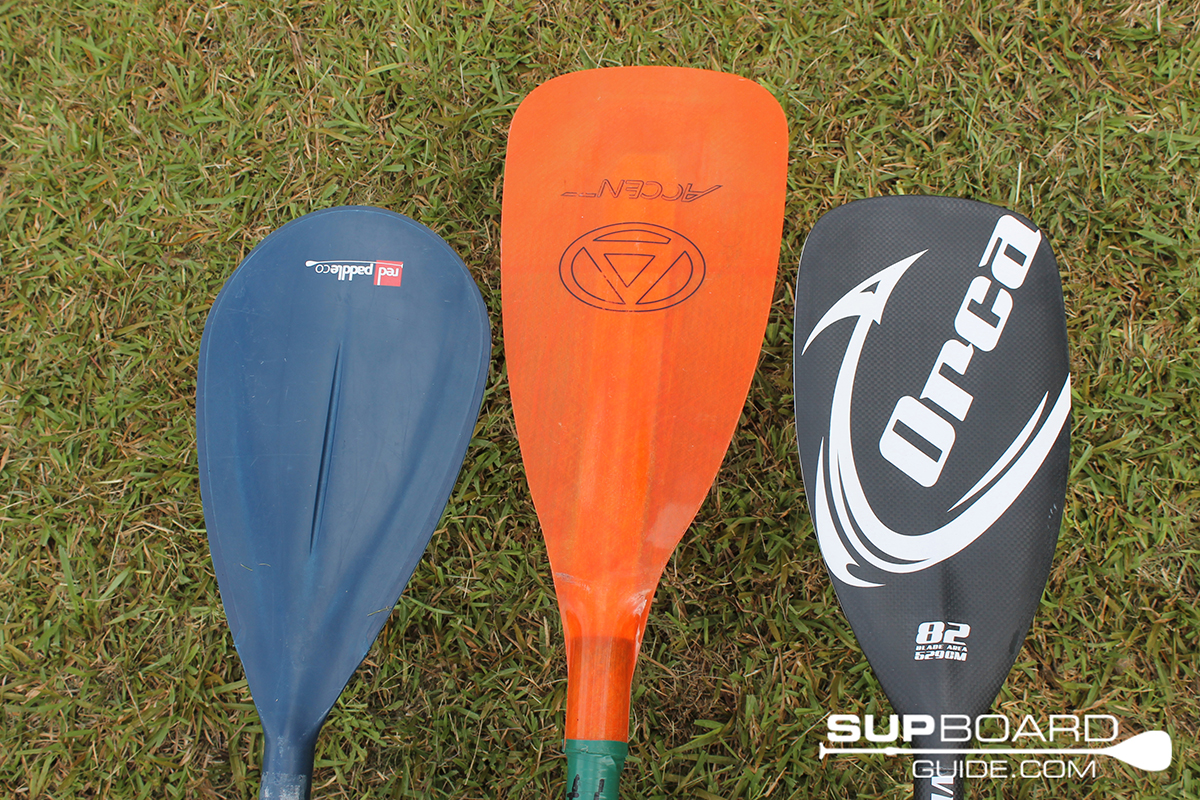
Because nylon blades are so flexy and lose a lot of power, the blade size tends to be bigger, and usually fairly square in profile. These are not intended to be high performance blades! They are excellent for beginner/intermediate paddlers, but anyone looking to improve technique, paddle further, faster etc, should definitely progress to something with a hard blade.
Hard blades are usually fiberglass-based, and may well have some carbon in there too, or indeed a wood veneer, which definitely looks pretty. Hard blades range from flat through to exotic foam-filled shapes, with pronounced concaves and foils. They’re much more fragile – the edges tend to be thin, maybe even sharp, so they’re very easily chipped. But in terms of performance they are in a very different league to the nylon blades.
The foam-filled blades allow for some very complex shapes; deep concaves, foiled scoops, double dihedrals (quoting from various manufacturers here), and all sorts of clever stuff going on. The foam core also increases the buoyancy of the blade, which aids with easy release.
Polycarbonate blades sit in between these two categories, in both stiffness and price. Polycarbonate looks like plastic but is slightly more see-through. Their shapes tend to be more oriented towards beginner/early intermediate paddling.
Blade size
This is one of the most important parameters in choosing a paddle, yet also one of the least well understood. It’s extraordinary how many articles and videos there are online talking about how a bigger blade ‘moves more water’! Yet that is actually the last thing we want to be doing – we’re actually trying to move the board. The general wisdom is that larger blades deliver more power with each stroke, and for sure, if you’re sprint-paddling, simply throwing in as many strokes per minute as you possibly can, and to hell with the actual quality of the stroke ( a paddling style which is sustainable for seconds rather than minutes), then a bigger blade will absolutely engage with more water and thus generate more power. This is why sprinters use a bigger blade, as do many paddlesurfers.
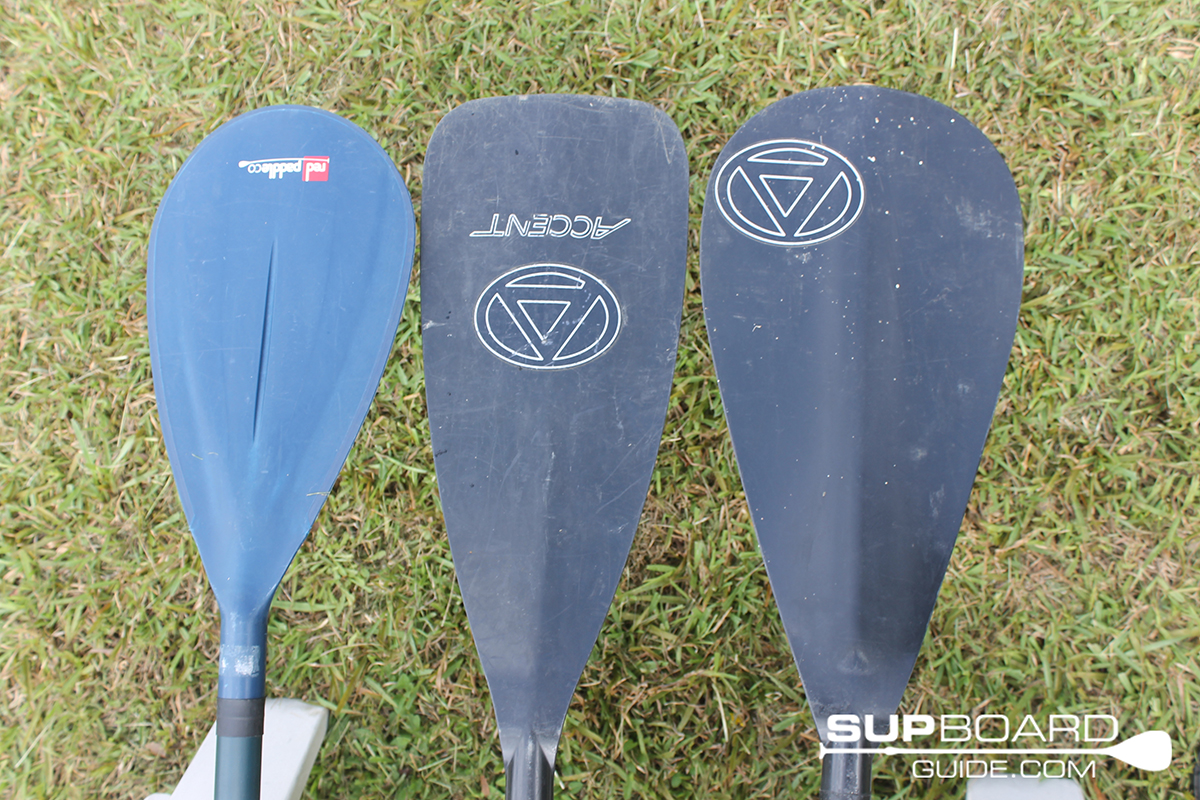
However, the other piece of general perceived wisdom about paddling is that smaller blades suit a faster cadence. Yet in our example above; those sprint paddlers using bigger blades – that’s actually the fastest cadence paddling you’re going to find! So what is going on here? The reality is that smaller blades will actually suit any cadence. You only need a blade big enough to achieve the catch – and that is determined by your technique. The better your paddling technique, the less paddle blade size you need. Coming back to our bike tyres analogy, think about riding uphill on grit. An experienced rider will find the right cadence and power to cruise uphill without the wheels spinning, even with quite narrow tyres. Whereas the less experienced rider needs wider tyres to get a grip. Acceleration tends to be slower with a smaller blade, but for normal paddling, a small blade is just less tiring and easier to use, if your technique is up for it. I have often found with clients changing to a smaller blade that it quickly exposes technique flaws that they didn’t know they had, but following a bit of remedial technique work they pretty quickly fell in love with the feel of the smaller blade. So, yes, a smaller blade makes more sense if you naturally like to paddle with a faster cadence, but it’s definitely not the case that if you like to paddle with a slower cadence you need a bigger blade.
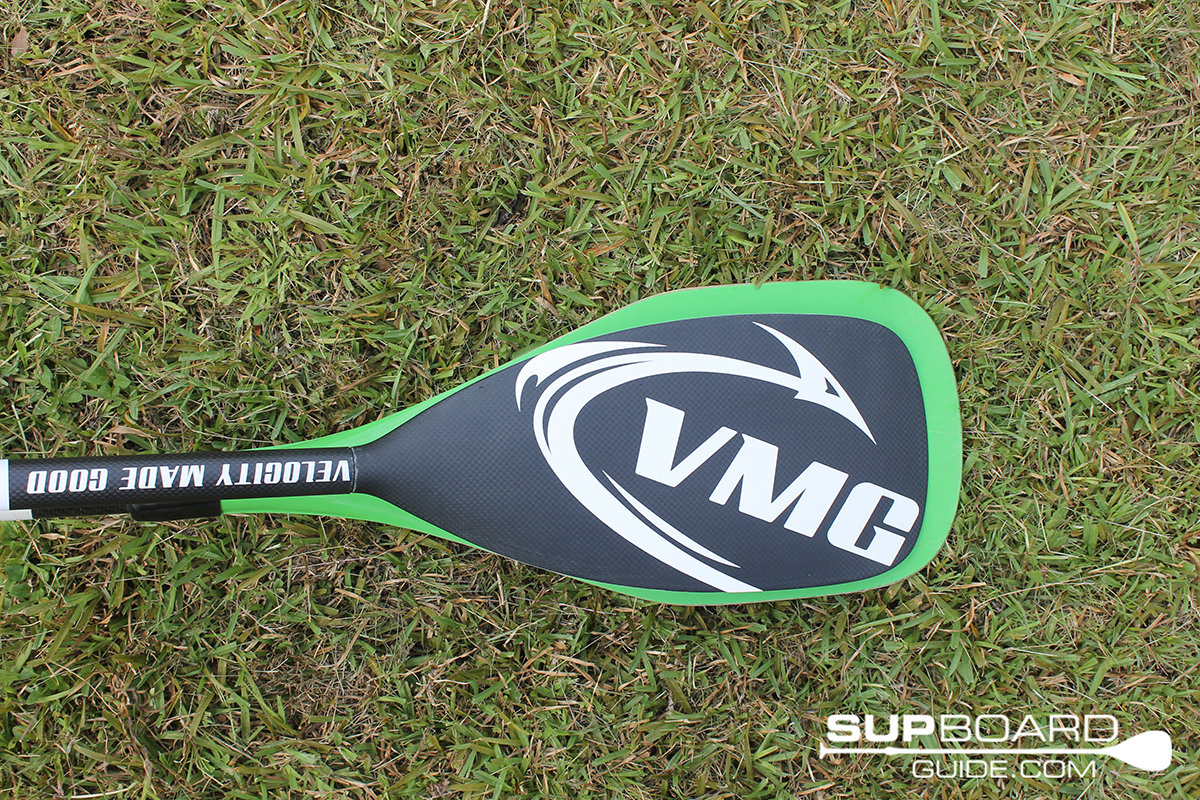
The picture is blurred slightly by the fact that many paddlers use a ‘sliding catch’; applying power to the paddle before the blade has fully entered the water. It’s less efficient; “4th gear paddling” rather than “5th gear”. But fit strong paddlers with energy to spare tend to find it an easier way to generate high power. (Exactly as per the gears analogy). For this sort of paddling, a slightly bigger blade works better too.
So – yet again – the picture is complex, and it’s hard to spit out exact numbers to give exact answers. We can make some useful generalizations though:
1. A smaller blade is easier on the body
2. A smaller blade is better for faster-cadence sustainable paddling
3. A smaller blade is better for longer distance paddling
4. A larger blade is often preferred for SUP surfing and SUP sprinting
5. A larger blade is more tolerant of poor technique (but still more tiring to use)
6. A larger blade is more suited to the ‘sliding catch’ style of paddling
7. It is a myth that bigger/more powerful people need bigger blades
So how small is small? Anything under 85” was once considered a very small blade, but, as paddle blade shape has become more sophisticated, there are plenty of powerhouse smaller blades out there. Smaller and lighter folk could definitely look at sub 80” paddles nowadays, while really, anything much bigger than mid 90s is now actually looking pretty old fashioned.
Blade shape
There are two elements to blade shape; the outline (plan shape) of the blade, and the shaping (ie the bumps, ridges, planes and hollows etc) built on to the power face of the blade
Blade Outline: Most blades tend to be either ‘teardrop’ or a more rectangular, parallel-sided and square-bottomed outline. Teardrop puts more width down low, meaning more immediate catch. This is great for paddlers who prefer a sliding catch, (or just don’t have a good catch!), and is also often favored for SUP surfing because the power comes on more immediately. Teardrop blades also tend to be a little bit shorter and wider (lower aspect) – with all the power at the tip, it would be overkill to put more width high up, and will also make the release much less clean.
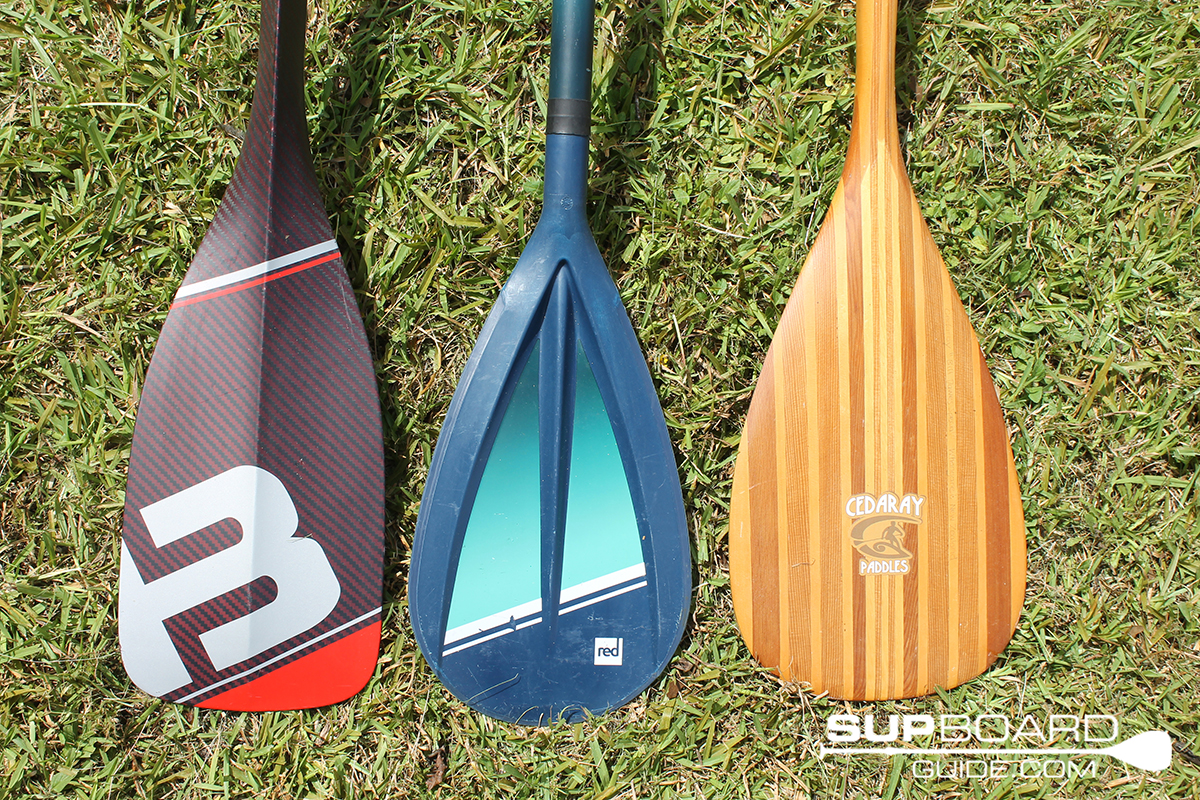
Conversely, blades with a rectangular shape tend to be narrower at the bottom than a tear-drop blade, which means less surface area is engaged when you first dip the blade in the water. So the power comes on more smoothly. Because of this, these blades can promote a gentler stroke and can be easier on your body. They also allow for a higher-cadence stroke. The blade needs to go in deeper to work properly, but if you have a clean catch then the blade is biting into deeper denser water, and works better. The release on the more rectangular paddles tends to favor the ‘straight out’ rather than out-to-the-side feathered style, as they have more area up high which can lift water if your release technique isn’t perfect.
Blade Shaping: Some blades have a completely flat power face. This is a no-compromise approach and very much for the highly competent paddler only. If your technique is up to it then that flat power face allows for a clean catch and rapid generation of maximum power, but it is very intolerant of anything less than excellent technique. If your catch isn’t perfect the blade will ‘flutter’ and generally feel awkward, jerky and uncomfortable. This is why a large proportion of paddles have some dihedral; a raised central spine making the blade into two planes rather than one, which creates a much more smooth, easy and forgiving catch. Ultimately it’s slightly less efficient but for anyone with less than perfect technique (ie 95% of paddlers!) it’s better overall.
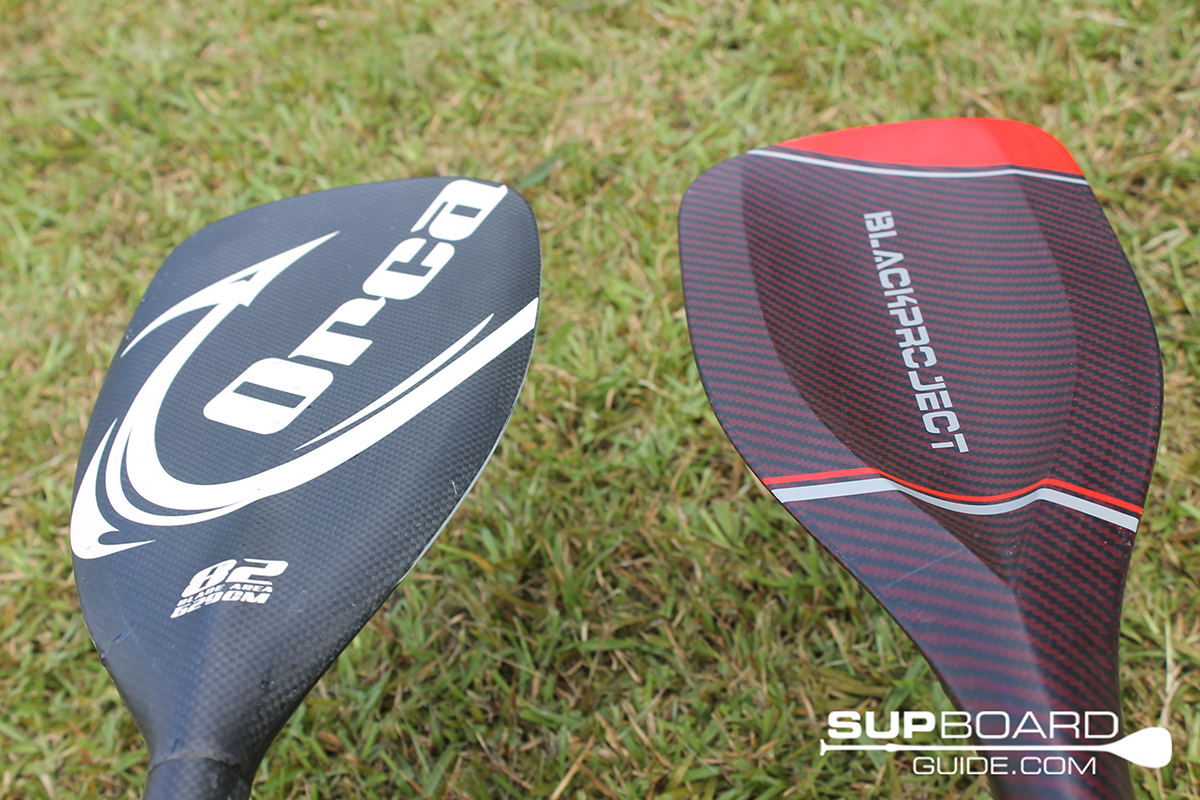
More recently, foam-filled and shaped blades have allowed for far more sophisticated power faces, with concaves and other devices, to assist in creating a perfect catch and power transfer. It’s beyond the scope of this article to go any further into these technical areas, but generally, blades like this tend to be found on high-spec, expensive paddles targeted at experienced operators, which is who they are best suited for. In my experience, paddles with shaped blades generally require quite a bit of time learning how to drive them to best effect. They all catch and release slightly differently, and you need to micro-adjust how and when you apply force to the shaft to get them working well. So if you don’t yet consider yourself a highly competent paddler, then looking for something with a relatively simple power face incorporating some dihedral is probably the best bet. Fairly flat-faced blades are also generally favoured by surfers, as it’s easier to skim the blade through the water when you’re on the wave.
Rake / Offset
The offset refers to the angle at which the blade angles away from the shaft. There is an internet myth that rake was introduced to prevent flutter, but to the best of my knowledge there’s no truth in it – people had been using straight paddles just fine for many years, until kayak legend Gene Jensen introduced the ‘bent shaft paddle’ in the 1970s. The bend improves the reach, the catch and the release, gives slightly more uplift at the start of the stroke and slightly less downforce at the back of the stroke, and within just a few years pretty much everyone was using one. But we’re actually only talking a few degrees. Few paddles have more than about 12 degrees, many less than 10. In general, paddling styles where you’re not reaching so far forward and are going high cadence, such as surfing and sprinting, suit lower angles, maybe just 7-8 degrees. All round and racing paddles have more blade angle, although it varies from manufacturer to manufacturer. Increased blade angle definitely gives a softer and more forgiving feel, and allows for an easier release. Again, exploring these subtle differences is not really what this article is about, but you do need to be aware of the general picture.
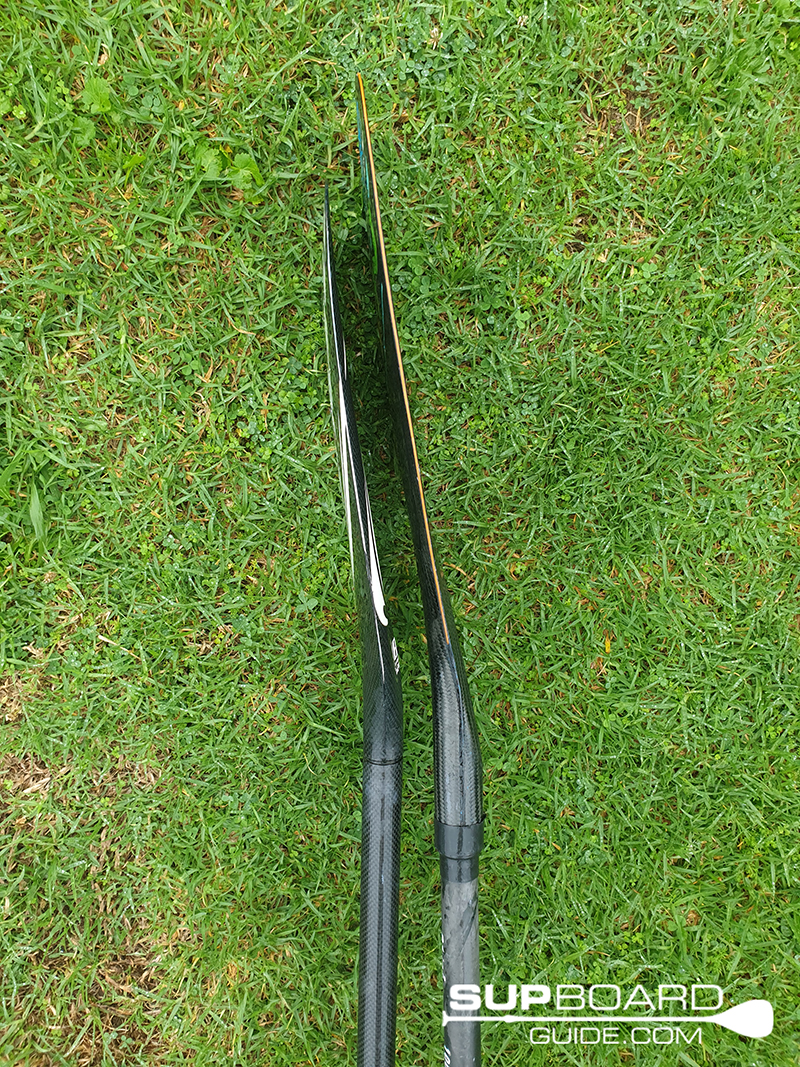
Paddle Configuration
By which we mean, is it fixed length or adjustable length, and how many pieces it comes in.
Adjustable length paddles obviously make a huge amount of sense, but it’s not all ticks in the advantages column. There are a huge variety of different adjustment systems on offer, ranging from simple to complex. Adjustable paddles are heavier (simply because there is more stuff), and the adjustment system can result in a lot of ‘shaft furniture’; clamps, cams, buttons etc which get in the way of the hands, and of course add weight and potential problems – more bits to break or lose. Systems that allow a completely smooth shaft, such as the Leverlock system, have quite a lot of moving parts, which can break. Adjustment systems can malfunction, causing the paddle to jam at a fixed length. Adjusting the length of a paddle also messes wildly with its stiffness – the paddle set at minimum length will be way stiffer than when it’s at maximum extension. And of course the paddle is less strong and stable when it’s at maximum extension, so if you’re a big strong person who puts a lot of load onto a paddle then you probably don’t want to be using a short paddle with a lot of extension, as you’ll probably end up breaking it.
For the beginner/intermediate paddler the advantages of being able to adjust the length of your paddle still massively outweigh these comparatively small disadvantages, but before you leave the shop you still want to ensure that you completely understand how the adjustment system works, and check that it does indeed lock tight. If you can still turn the handle when the clamp (or whatever) is closed, then that needs sorting out before you hand over your money. If the handle can move independently of the shaft then it will, and it will hugely impact upon your paddling.
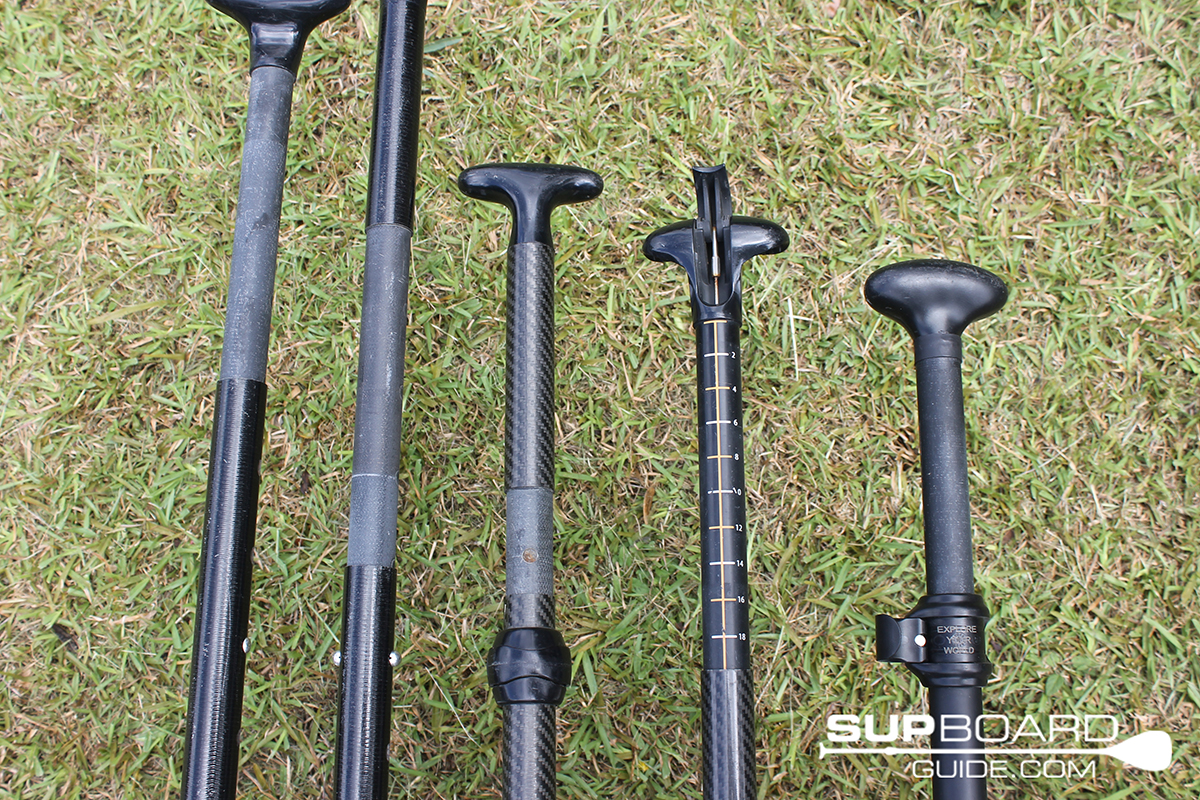
Adjustable paddles are great but don’t necessarily pack down much shorter, which is why multi-piece paddles – where the blade is removable as well as the top section – are so popular.
Three piece is the norm, and works well to create a paddle that will fit inside an iSUP bag. Most 3 piece paddles are adjustable in length, but not all. Some of the latest Compact boards come with 5 piece paddles, and sometimes on these there is still some movement between the sections even when they are (supposedly) locked together, which makes for a very spongy feel. If the paddle doesn’t feel rigid, it’s never going to work well.
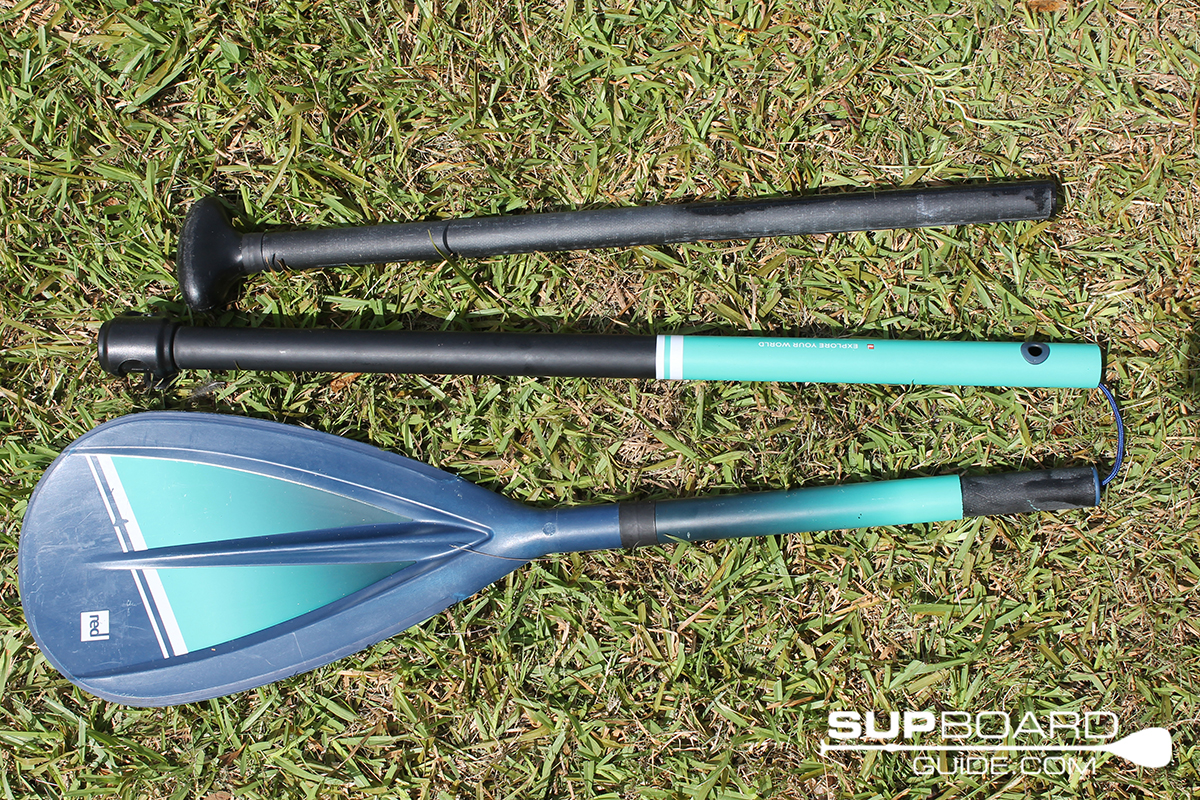
Paddle Weight
Light is definitely good. In general, the lighter, the better. But too light might just mean that the shaft wall is super thin, and will crack or snap at the earliest opportunity. Many manufacturers have fallen foul of this, with entire batches of super expensive high performance race paddles snapping like dry spaghetti within their first few outings, simply because the manufacturer chased the ‘ultimate lightness’ ideal a bit too hard. If you are going to invest in a really top-end super light paddle, get it from a reputable manufacturer that has been around for a while, and find out what the warranty is regarding breakages!
The balance point is also a feature when discussing weight. A heavy blade on a light shaft creates a lot more swing weight, which is more fatiguing over longer sessions. When you pick a paddle up, see where the balance point is. The nearer to the centre of the shaft, the better!
Paddle length
I’ve left this one till last, because it’s the most controversial, and difficult to be precise about. It’s one of the most important parameters, but on any adjustable paddle it’s also the one you do actually have control over, so – as long as your adjustment system works – it’s not a deal breaker in terms of choosing a paddle.
So what height should your paddle be set to? Despite what countless youtube vids will try to tell you, there is no ‘correct’ size for a paddle! There isn’t a formula that you can plug all your variables into and it will spit out the right length for you. Bodies move differently. Limb lengths vary. Shoulder width varies. Bodymass centers are at different heights. And of course, it also depends a whole lot on what you’re actually doing with the paddle…
Check out this pic of me with three of my paddles. On the left is my surfing paddle, the middle one is my short-middle distance racing paddle, on the right is my cruising or longer distance paddle. Although in certain surf scenarios I’ll use my short-distance racing paddle, for more explosive power. For white water or downwinding I have different lengths also, which is also influenced by the board I’m riding, because obviously if the board is thicker then I’ll need a longer paddle to reach the water, yet if the board is narrower, I don’t need so much paddle length…
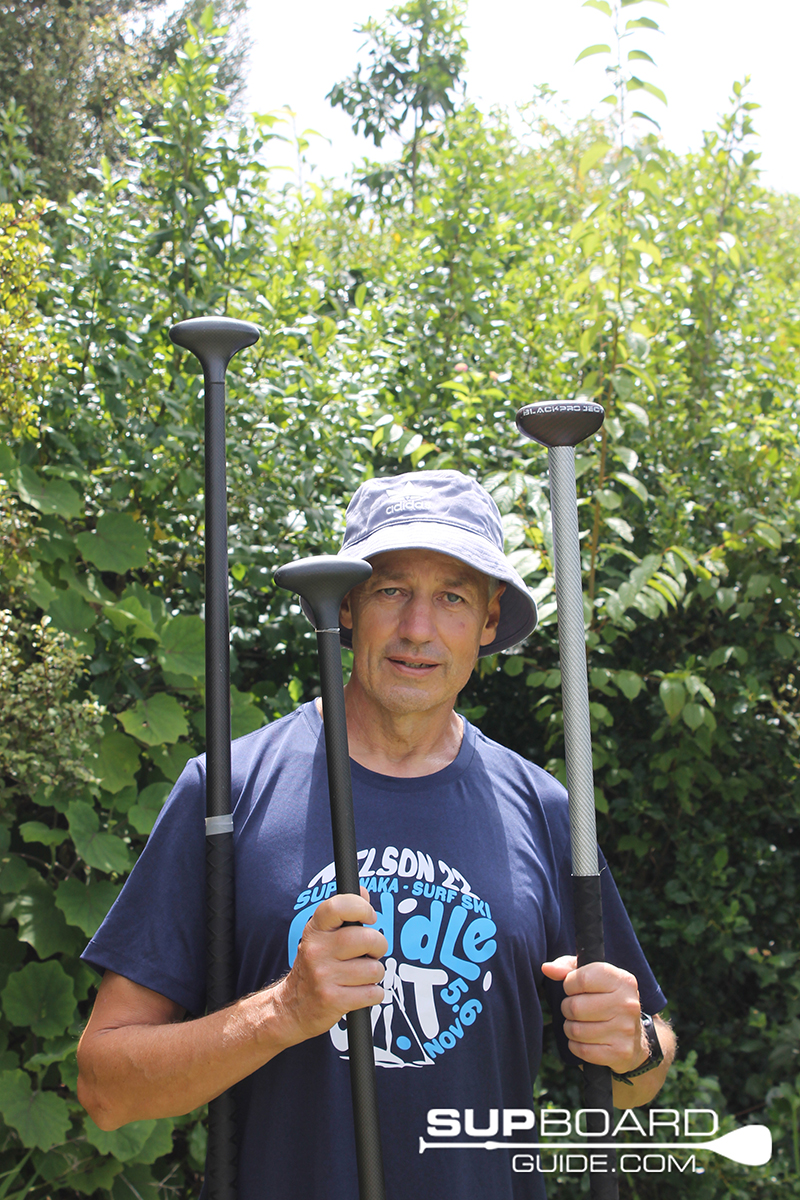
And even then it’s not a constant. Some days you’re feeling a bit more cruisy, so you might want a slightly longer paddle so you can be a bit more upright and lower cadence. Other days you really just want to crank, so go for a shorter paddle which will naturally tend to raise your cadence and commitment.
If that wasn’t enough to leave you banging your head against the wall in the search for a simple answer to what seems like it should be a really simple question, we haven’t even hit on the most important factor of all yet: Your ideal paddle length actually ends up being determined most of all by the way you paddle. Which is different for everybody, and may be influenced by who taught you, or which youtube vids you’ve been watching, or just how you’ve worked it out for yourself.
But you’ve got to start somewhere, so – in our SUP school we start out our beginners with a paddle set to around 9-10” (25cm) taller than the person. And then we watch how their paddling progresses once they’re on the water, and we’ll adjust the length from there. Sometimes shorter, sometimes longer. (We do often find that taller, longer-limbed folk tend to find a slightly shorter paddle more comfortable, while squat, compact people prefer longer. But it’s certainly not always the case).
This is why, if you’re relatively new to SUP, or a particular area of SUP (ie you are looking to get into sup surfing, for example), then you must get an adjustable length paddle, because you simply cannot know what is going to be the right paddle length for you until you’ve got quite a lot of hours of paddling under your belt, and really started to develop proper technique. (Although it’s hard to learn proper technique with a nylon-bladed beginner paddle anyway). Start from the 9-10” overhead, and once you’ve progressed beyond the beginner stage, just experiment – try a slightly longer or shorter setting and see how it feels. Just be aware that changing the length may also require you to change your paddling technique slightly to ensure you’re still paddling properly. So there are several things all going on here at once. Initially, you may well feel the difference simply in terms of comfort. Indeed, there are some paddle length guides online that focus primarily on this aspect, along the general approach of too long a paddle will bother your shoulders, while if it’s too short you’ll feel it in your lower back. So you tune your paddle according to where it hurts!
There is some merit in this, but it’s not infallible. You’ll note that, looking back at the pic of me with 3 of my paddles, they’re all less than 10” longer than me – indeed my surf paddle is shorter than I am. But I’ve been paddling for 15 years and my body has adjusted to shorter paddles over that time. Whereas I suspect that if I were starting out as a newbie paddleboarder now, such a short paddle would cause me a whole lot of back issues, and probably really screw up my technique development too.
So the reality really is that correct paddle height is a variable, not a constant. It doesn’t only change as you change environment (or mood!), it also changes as you develop – usually towards shorter paddles, but not always. As said, it’s a whole lot of complex!
Paddles for White Water
This is a specialist area of paddling with its own requirements, both in terms of performance and durability. (If your paddle is going to get snagged on rocks and obstacles every session then durability is going to matter more than performance!). Paddles tend to be shorter than racing paddles but longer than surfing paddles. Many white water paddlers prefer the rectangular style of blade as it goes deeper. If you’re wanting to get into white water paddling then talk to other white water paddlers about what they’re using.
Choosing Your Paddle
So now you understand a bit more about the various aspects of a paddle, use the table below to work out what you need. Follow this checklist:
1. Start by deciding which column you’re looking in – are you a beginner, a progressor (wanting an all round paddle), or are you purchasing specifically for a particular discipline.
2. Use the column to guide you towards the right blade size, shaft stiffness and offset angle, factoring in the extra notes below the table.
3. Decide whether you want fixed length or adjustable.
4. Decide how much you can afford to spend. Don’t scrimp on this. As explained at the beginning of this article, your paddle is pretty much the sum total of the tactile experience of paddleboarding. The better your paddle, the more you’ll enjoy it. Remember though, “better” isn’t just about having more carbon – it’s the whole paddle package. If you are buying this paddle as an upgrade then aim for something with hard (non nylon) blade and a composite shaft, at very least. The performance gains from these two factors alone will be immense.
5. Now you have a good idea of the essential parameters you need, you can start shopping. If at all possible, hold the paddle in your hand before you buy it, so you can check out the handle style, the shaft section or diameter, and how the adjustment/assembly system works and feels. All of which also have a massive impact on determining how well your paddle works for you.
Happy paddling!
| Beginner | Progressor | Surfing/Sprinting | Distance/Racing | |
| Handle | Personal preference (1) | Personal preference (1) | Personal preference (1) | Personal preference (1) |
| Shaft Construction | Alu if cost the only consideration, otherwise fiberglass | composite | composite | Composite / full carbon |
| Shaft Section | Personal preference (1) | Personal preference (1) | Personal preference (1) | Personal preference (1) |
| Shaft Diameter | Personal preference (1) – recommend narrower for smaller hands | Personal preference (1) – recommend narrower for smaller hands | Personal preference (1) – recommend narrower for smaller hands | Personal preference (1) – recommend narrower for smaller hands |
| Shaft Stiffness | soft/med | med(2) | med/stiff (2) | med/stiff (2) |
| Blade Construction | Nylon or fiberglass | Fiberglass or Composite | Fiberglass or Composite | Fiberglass or Composite |
| Blade Size | As it comes (3) | Medium | Medium | Medium/Small (4) |
| Blade Shape | shovel/teardrop | Not shovel! | teardrop/rect | rect |
| Rake / Offset | 8-11 if fiberglass blade (5) | 9-11 | 7-9 | 10-13 |
| Configuration | Adjustable/3 -5 piece | Adjustable/3 -5 piece | Fixed length is best | Fixed length is best |
| Paddle weight | Lighter is better (6) | Lighter is better (6) | Lighter is better (6) | Lighter is better (6) |
| Paddle length | Adjustable, Start with 8-10” overhead | Adjustable | Shorter; head high to +4”(7) | 3-8” overhead according to technique (6) |
If you’re unsure about any particular element in this table, refer back to the detailed descriptions in the main article above.
Footnotes to the above table
1Personal Preference. You may wonder why we’ve even put this here if we’re not going to give any guidelines as to how to choose what is right for you. The reason is that it genuinely does come down to personal preference, but it really matters. If you don’t like the feel of the handle, or the shaft section, it’s really going to impact your enjoyment of the paddle. So it’s very important to consider it as part of your purchasing process.
2Go for less shaft stiffness if you are small, light or have any problems with shoulders or elbows. Stronger and/or heavier paddlers should go stiffer.
3Blade size isn’t usually quoted with nylon paddles, and because they’re pretty flexy they’re usually fairly forgiving. Nevertheless, some nylon blades are a lot smaller than others, and – particularly smaller/lighter folk – will definitely benefit from the smaller blade.
4More and more competitive paddlers are turning to smaller blades, as once you have a well-developed catch you simply don’t need any more blade size. Rather than bigger blades for shorter distances, many paddlers opt for a stiffer shaft instead, thus developing more power but still with that nice small blade.
5Offset angles are pretty much irrelevant on nylon blades, because these blades tend to be far more ‘spoon’ in profile, and flex significantly anyway when under load, so their offset angle changes considerably.
6A lighter paddle is always a better experience, but function is more important. For beginners and progressors having an adjustable length paddle is much more important than just going for the lightest paddle available. Durability matters too. If you are into hard surfing, jamming that paddle into the wave and really leaning on it, then you need a paddle that’s tough enough for the job. Same with sprinting. Whereas for longer distance racing weight matters more, and hopefully your paddle won’t be taking so much of a beating.
7If you’re choosing a paddle for reasonably high performance in surfing or racing then you’re probably going to go for a one-piece, so you’re going to need a pretty clear idea as to how long you want it. If your new paddle is alongside a new board purchase, remember that if the new board is of different width or thickness to your existing one then this will also impact on your ideal paddle length. Always play safe and err on cutting it slightly too long, because it’s easy to then shorten it a bit more, if necessary.
Bill Dawes
Latest posts by Bill Dawes (see all)
- Thurso Waterwalker 132-12 iSUP Review – 2025 - June 18, 2025
- Red Paddle Co 11’3 Sport MSL 800 iSUP Review – 2025 - June 17, 2025
- Red Paddle Co Ride 11’6 iSUP Review – 2025 - June 16, 2025




